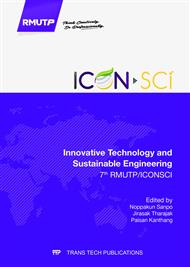p.3
p.8
p.12
p.17
p.21
p.25
p.29
p.33
Effect of Fish Scales Gelatin and Mixing Ratio on Chemical and Mechanical Characteristics of Gelatin/Chitosan Films
Abstract:
The objective of this work was to compare the chemical properties and mechanical properties (strength and elongation) of gelatin/chitosan (G/Ch) films. The effect of several fish scales such as white perch, java barb, red tilapia and nile tilapia scales and mixing ratios of G/Ch composite was investigated. Several fish scales were cleaned and treated with 1.0 M NaOH and 0.8 M acetic acid at room temperature for 120 min to remove fat. Gelatins were extracted from fish scales using the distilled water at 70°C for 120 min. Chitosan solution was prepared with 1% (w/v) chitosan in 1% (v/v) acetic acid, stirred at room temperature. After that, the G/Ch films were prepared by mixing the fish scale gelatins and chitosan with different ratios and then dried at 70°C. The results showed that the FT-IR of G/Ch films revealed the function groups of both gelatin and chitosan. The gelatin films showed peaks amide A (3219-3315 cm-1), alkane (2930-2958 cm1, 1400 -1479 cm-1and 675-1000 cm-1), amide I (1630-1655 cm-1), amide II (1520-1560 cm-1), amide III (1220-1335 cm-1), and ether (1020-1035 cm-1). The chitosan films showed peaks amide II (1559 cm-1), alkane (1404 cm-1) and ether (1022 cm-1). The tensile strength results of G/Ch films increased and elongation of G/Ch films decreased with increasing the amount of chitosan.
Info:
Periodical:
Pages:
8-11
Citation:
Online since:
June 2017
Keywords:
Price:
Сopyright:
© 2017 Trans Tech Publications Ltd. All Rights Reserved
Share:
Citation:


